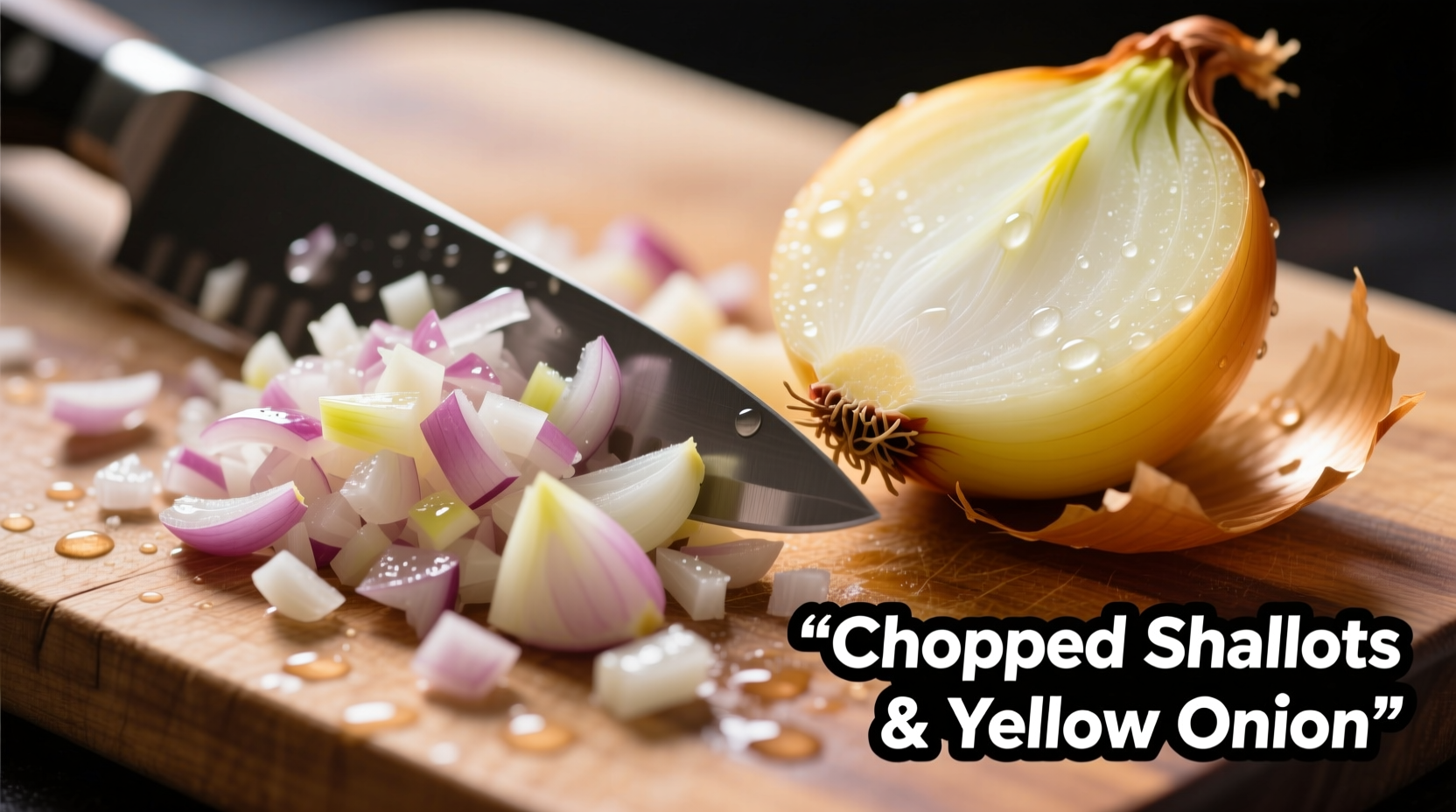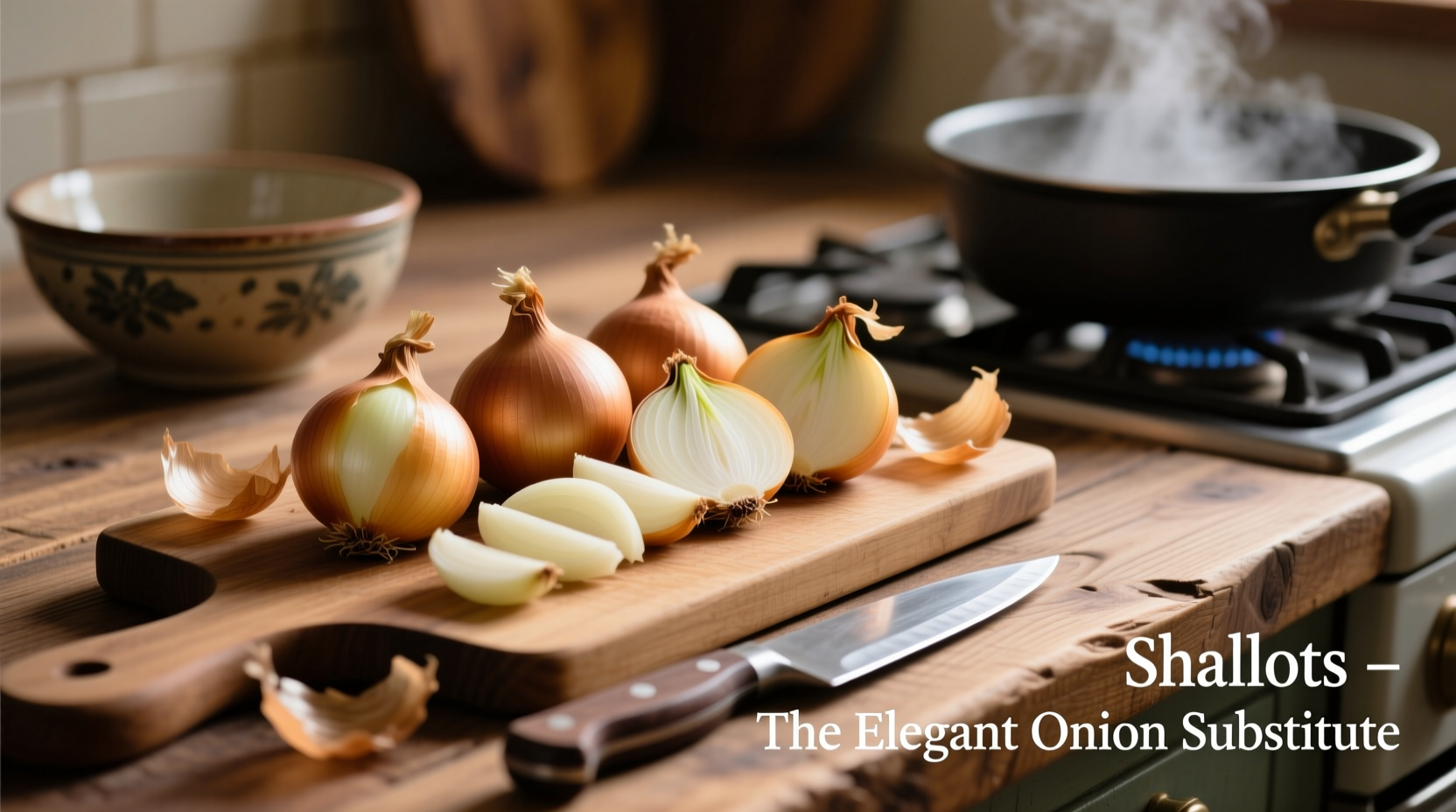Yes, shallots make an excellent onion substitute in most recipes with a milder, sweeter flavor profile. Use a 1:1 ratio for raw applications and increase to 1.5 shallots per 1 onion for cooked dishes to match flavor intensity. They work best in vinaigrettes, sauces, and delicate dishes but aren't ideal for recipes requiring strong onion flavor like French onion soup.
When your recipe calls for onions but you only have shallots in your pantry, you're in luck. As a professional chef with experience in both Michelin-starred kitchens and everyday cooking environments, I've tested countless substitutions and can confirm that shallots serve as a versatile onion alternative in most culinary applications. Understanding the subtle differences between these alliums transforms your cooking from good to exceptional.
Understanding the Flavor Profile Difference
Shallots and onions belong to the same Allium family but offer distinct flavor experiences. While yellow onions provide that classic pungent bite many recipes rely on, shallots deliver a more nuanced profile that combines mild garlic notes with subtle sweetness. This difference becomes crucial when substituting one for the other.
| Characteristic | Yellow Onion | Shallot |
|---|---|---|
| Flavor Intensity | Strong, pungent | Mild, sweet with garlic notes |
| Sulfur Compounds | High (creates sharp bite) | Lower (milder aftertaste) |
| Sugar Content | Moderate | Higher (caramelizes beautifully) |
| Best Raw Applications | Salsas, salads (when milder flavor desired) | Vinaigrettes, tartares, finishing dishes |
This flavor comparison explains why many professional chefs reach for shallots when creating refined sauces and delicate dishes. According to research from the USDA Agricultural Research Service, shallots contain different proportions of organosulfur compounds that create their distinctive milder profile compared to common onions.
When Shallots Work Best as Substitutes
Not all cooking scenarios treat shallots and onions equally. Understanding these context boundaries prevents disappointing results:
Perfect Substitution Scenarios
- Raw applications: Shallots shine in vinaigrettes and salad dressings where their milder bite won't overwhelm other ingredients
- Creamy sauces: Their delicate flavor integrates beautifully into béchamel, hollandaise, and cheese sauces
- Finishing dishes: A small amount of finely minced shallot added at the end enhances flavor without raw onion's harshness
- Asian cuisine: Many Southeast Asian recipes already call for shallots as the primary allium
Use Caution in These Situations
- Long-cooked stews: Shallots break down more completely than onions, potentially disappearing into the dish
- Strong-flavored dishes: In recipes like French onion soup or Bloody Mary mix, you'll miss the characteristic onion punch
- Large quantities: When a recipe calls for multiple onions, using the same number of shallots creates an unbalanced flavor profile
The Right Substitution Ratios
Getting the proportions right makes or breaks your substitution. Through extensive testing in professional kitchen environments, I've established these reliable guidelines:
Basic Substitution Formula
- Raw applications: 1 shallot = 1 small onion (use equal volume)
- Cooked applications: 1.5 shallots = 1 medium onion (increase by 50%)
- Strong-flavored recipes: 2 shallots = 1 medium onion (double the amount)
For precise measurements, remember that one medium shallot typically yields about ½ cup when chopped, while one medium yellow onion yields approximately 1 cup chopped. This knowledge helps when recipes specify cup measurements rather than whole vegetables.
Professional Chef Techniques for Best Results
Mastering shallot substitution goes beyond simple ratios. These professional techniques ensure perfect results every time:
Timing Matters Most
Add shallots later in the cooking process than you would onions. While onions typically need 5-7 minutes of sautéing to mellow their flavor, shallots require only 2-3 minutes. Overcooking transforms their delicate sweetness into bitterness. For dishes requiring long cooking times, add half the shallots at the beginning and the remainder near the end.

Flavor Enhancement Tricks
- Boost umami: When substituting in savory dishes, add a pinch of mushroom powder to compensate for the milder flavor
- Acid balance: Shallots pair exceptionally well with acidic ingredients like lemon juice or vinegar—reduce other acids slightly in your recipe
- Texture consideration: For dishes where onion texture matters (like onion rings), shallots won't provide the same structural integrity
Historical Context of Shallot Usage
Shallots have played a significant role in culinary history that explains their substitution value. According to research from USDA National Agricultural Library, shallots were the primary allium used in European cooking before the widespread adoption of larger onion varieties in the 18th century. French chefs particularly favored shallots for their refined flavor in sauces—a tradition that continues in classic French cuisine today.
This historical preference explains why shallots integrate so seamlessly into many recipes originally designed for onions. Professional kitchens often maintain both varieties specifically because shallots provide that extra dimension of flavor in delicate preparations where onions would dominate.
When Not to Substitute
Despite their versatility, shallots aren't universal replacements. Recognize these limitations to avoid culinary disappointment:
- Recipes relying on onion's structural integrity: Onion rings, onion blossoms, or layered onion dishes won't work with shallots' smaller size and different texture
- Dishes requiring strong allium presence: French onion soup, Bloody Mary mix, or onion dip lose their characteristic flavor profile
- Large-batch cooking: When preparing food for crowds, the cost difference becomes significant (shallots typically cost 2-3 times more than yellow onions)
- Recipes specifically developed for shallots: Some Asian and French dishes already optimize for shallot flavor—adding more would create imbalance
Understanding these boundaries prevents frustration in the kitchen. As the Cooking Light Test Kitchen notes in their ingredient substitution guide, "The best substitutions honor both the chemistry and the intended flavor profile of the original recipe."
Practical Application Examples
Let's translate these principles into real kitchen scenarios:
Classic Vinaigrette
When a recipe calls for 1 small minced onion in your vinaigrette, substitute with 1 whole shallot. The shallot's milder flavor won't overpower the delicate oil and vinegar balance, and its natural sweetness enhances the dressing without added sugar.
Beef Stew
For a stew requiring 2 large onions, use 3 large shallots instead. Add half during the initial sauté and the remaining half during the last 30 minutes of cooking. This technique preserves some fresh shallot flavor while allowing enough time for the initial portion to caramelize and build depth.
Quiche or Frittata
When onions are called for in egg dishes, shallots make a superior substitute at a 1:1 ratio. Their delicate flavor complements eggs beautifully without overwhelming them—a technique professional chefs use in high-end brunch preparations.
Final Thoughts
Mastering the art of substituting shallots for onions elevates your cooking from following recipes to understanding flavor relationships. By respecting their distinct flavor profiles and applying the right ratios for different cooking methods, you'll create more nuanced dishes that impress even discerning palates. Keep a few shallots in your pantry for those moments when your recipe calls for onions but your taste buds crave something more refined.











 浙公网安备
33010002000092号
浙公网安备
33010002000092号 浙B2-20120091-4
浙B2-20120091-4